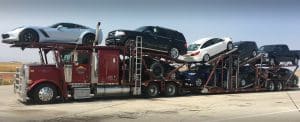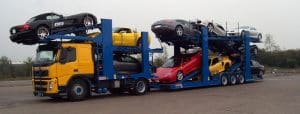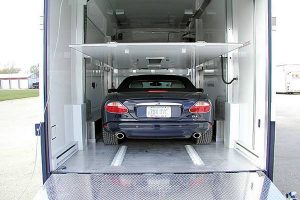Understanding Open Vs. Enclosed Transport
When deciding between open and enclosed transport for vehicle shipping, it is crucial to understand the fundamental differences and benefits of each method. Open transport is the most common and cost-effective option, involving vehicles being loaded onto an open trailer, typically exposed to the elements. This method is widely used due to its affordability and availability. Open carriers can transport more vehicles at once, reducing overall costs for consumers.
However, because vehicles are exposed to weather conditions and road debris during transit, there may be a slightly higher risk of minor damage.
On the other hand, enclosed transport offers a premium level of protection by housing vehicles within a fully enclosed trailer. This method shields cars from external factors such as rain, snow, dust, and potential road hazards. Enclosed transport is particularly beneficial for high-value or classic cars that require extra care during transit. Owners of luxury or antique vehicles often prefer this method to ensure their prized possessions arrive in pristine condition.
Despite the higher cost associated with enclosed transport—often ranging from 30% to 50% more than open transport—the added peace of mind can be invaluable for those transporting valuable or rare automobiles. Additionally, enclosed carriers typically handle fewer vehicles per trip compared to open carriers, allowing for more personalized service and potentially faster delivery times.
Ultimately, the choice between open and enclosed transport depends on your specific needs and priorities. If cost-efficiency is paramount and your vehicle doesn’t require special protection, open transport might be the best choice. Conversely, if safeguarding your vehicle’s condition is a top concern—particularly for high-value models—opting for enclosed transport provides enhanced security throughout the journey.
Pros And Cons Of Open Transport
When deciding between open and enclosed transport for shipping a vehicle, understanding the pros and cons of open transport can significantly aid in making an informed choice. Open transport is the most commonly used method for vehicle shipping and involves transporting cars on trailers exposed to the elements, typically multi-car carriers.
One of the primary advantages of open transport is its cost-effectiveness. Because these carriers can haul multiple vehicles simultaneously, operational costs are divided among several customers, resulting in lower individual shipping costs. This makes it an attractive option for budget-conscious consumers or those who need to ship multiple vehicles at once. Furthermore, due to its popularity and widespread use, scheduling an open transport shipment tends to be quicker and more flexible compared to enclosed options.
However, there are notable drawbacks associated with open transport. The most significant concern is exposure to environmental elements such as rain, snow, dust, and road debris. While professional carriers take precautions to secure vehicles properly, they cannot entirely eliminate the risk of minor cosmetic damage from such exposure. This potential vulnerability might be a dealbreaker for owners of high-value or classic cars who seek maximum protection during transit.
Another downside includes increased visibility which could lead to potential security risks when transporting valuable vehicles over long distances. Although rare, theft or vandalism can occur during stops or layovers.
In conclusion, while open transport offers undeniable benefits such as lower costs and greater scheduling flexibility, it also presents risks related primarily to environmental exposure and security concerns. Evaluating these factors in relation to your specific needs will help determine whether this method aligns with your priorities for vehicle transportation.
Advantages Of Enclosed Transport
When deciding between open and enclosed transport for your vehicle, understanding the advantages of enclosed transport can significantly influence your choice. Enclosed transport offers a higher degree of protection compared to its open counterpart, making it an ideal option for owners of luxury, classic, or high-value vehicles. The primary advantage lies in the full enclosure that shields your car from external elements such as harsh weather conditions, road debris, and potential damage during transit.
Enclosed carriers are typically designed to carry fewer vehicles at a time—usually between two to six—ensuring more personalized attention and care for each car. This reduced load also translates into less frequent loading and unloading operations, thereby minimizing the risk of accidental damage. Additionally, many enclosed carriers are equipped with advanced security features such as hydraulic lift gates and specialized tie-down mechanisms that offer extra layers of safety.
Another significant benefit is privacy. If you own a high-profile or rare vehicle that might attract unwanted attention during transit, enclosed transport ensures that your car remains out of sight throughout the journey. This is particularly valuable when transporting prized collectibles or prototypes where discretion is crucial. Moreover, professional drivers who operate enclosed transport services often have specialized training in handling luxury and exotic cars.
Their expertise adds an additional level of confidence that your vehicle will arrive at its destination in pristine condition. Insurance coverage tends to be more comprehensive with enclosed transport options as well. Given the added risks associated with transporting high-value vehicles, many companies offer higher levels of insurance for enclosed shipments compared to open ones.
Cost Comparison: Open Vs. Enclosed Transport
When deciding between open and enclosed transport for your vehicle, cost is a significant factor to consider. Generally, open transport is more economical than enclosed transport. This price difference can be attributed to several factors.
Open carriers can usually accommodate up to ten vehicles at a time, maximizing efficiency and reducing costs per car transported. The high capacity of these carriers means that the overall expense is distributed across multiple customers, making it a budget-friendly option for many. Additionally, the widespread availability of open carriers contributes to competitive pricing in the market.
Conversely, enclosed transport typically involves higher costs due to its specialized nature. Enclosed carriers often hold fewer vehicles—usually between two and six—resulting in higher per-vehicle transportation costs. These carriers offer added protection from external elements like weather conditions and road debris, which justifies their premium pricing. Furthermore, enclosed trailers often have advanced features such as hydraulic lift gates or climate control systems that add to operational expenses.
While the initial outlay for enclosed transport may seem steep compared to open transport, it’s crucial to weigh this against potential risks and additional expenses associated with damages during transit in an open carrier. For high-value or classic cars where repairs could be costly or parts rare, the investment in enclosed shipping might provide peace of mind that offsets its higher price tag.
Ultimately, your choice should hinge on how much value you place on cost versus protection. While open transport is ideal for most standard vehicles due to its affordability, opting for enclosed transport might make more sense if you’re transporting an expensive or sentimental vehicle that warrants extra care during its journey.
Evaluating Your Vehicle’s Needs
When deciding between open and enclosed transport, evaluating your vehicle’s specific needs is crucial. Your vehicle’s value, condition, and usage play pivotal roles in determining the most appropriate mode of transportation. High-end luxury cars, classic cars, or vehicles with sentimental value typically benefit from the added protection of enclosed transport. This method shields them from potential damage caused by weather conditions, road debris, and other environmental factors during transit.
Consider the vehicle’s exposure to elements as a critical factor. Open transport leaves vehicles vulnerable to rain, snow, hail, and even intense sunlight over long distances. While this might not be a significant concern for everyday vehicles or those that can easily withstand minor wear and tear, it is a crucial consideration for more delicate or high-value automobiles.
Another aspect to ponder is the distance and route of your shipment. Enclosed carriers are often recommended for longer journeys where the risk of encountering adverse weather conditions increases. Additionally, if your route includes areas prone to severe weather or challenging driving conditions, opting for an enclosed carrier could mitigate risks.
The frequency of use also matters; daily drivers might manage well with open transport due to their regular exposure to various elements. In contrast, show cars or collector’s items that spend most of their time in controlled environments would greatly benefit from the additional layer of security provided by an enclosed carrier.
Ultimately, understanding your vehicle’s specific requirements will guide you in making an informed decision between open and enclosed transport options. This thorough evaluation ensures that you choose the safest and most practical method tailored to protect your investment effectively during transit.
Assessing Weather And Road Conditions
When deciding between open and enclosed transport for your vehicle, assessing weather and road conditions is a crucial step. The environment your vehicle will travel through can significantly impact its safety and overall condition upon arrival.
Open transport, where vehicles are exposed to the elements on an open trailer, is generally more economical but leaves your car vulnerable to various weather conditions. If the journey involves traversing regions known for unpredictable or severe weather, such as heavy rain, snowstorms, or hail, opting for enclosed transport might be the wiser choice. Enclosed carriers shield your vehicle from these elements, providing an added layer of protection against potential damage caused by harsh weather.
Furthermore, consider the time of year when planning your transport. Winter months pose risks not only due to snow and ice but also because road salt used in de-icing can cause corrosion if it accumulates on your vehicle. In such scenarios, enclosed transport offers substantial benefits by keeping your car isolated from these corrosive materials.
Road conditions themselves also play a role in this decision. Routes that pass through areas with poor infrastructure or under construction could increase the likelihood of debris striking the vehicle if it’s on an open carrier. Dusty roads or those with loose gravel can lead to scratches and dents that would otherwise be avoided with enclosed shipping.
In summary, while open transport may be sufficient for shorter distances in mild climates with well-maintained roads, enclosed transport offers peace of mind against adverse weather and challenging road conditions. By carefully evaluating these factors ahead of time, you can make a more informed choice that ensures the safe delivery of your vehicle without unexpected damage.
Making The Final Decision: Which Is Right For You?
Choosing between open and enclosed transport ultimately depends on your specific needs, priorities, and circumstances. Both options have distinct advantages and potential drawbacks that can influence your decision.
Open transport is often favored for its cost-effectiveness. If budget constraints are a primary concern, this method offers a reliable solution without breaking the bank. It’s particularly suitable for standard vehicles that don’t require extra protection or specialized handling. The visibility of vehicles during transit also provides some peace of mind, as you can easily inspect them upon arrival.
On the other hand, enclosed transport is an ideal choice for those who prioritize maximum protection and security. This option shields your vehicle from external elements such as weather conditions, road debris, and potential vandalism. It’s especially beneficial if you own a high-value car, classic automobile, or any vehicle with sentimental value that warrants extra care. The additional cost associated with enclosed transport can be seen as an investment in preserving the condition of your prized possession.
Consider the specifics of your journey as well. For long-distance moves or routes known for unpredictable weather patterns, enclosed transport offers added reassurance against unforeseen challenges. Conversely, if your route is relatively short and traverses stable climates, open transport remains a viable option.
Ultimately, weigh these factors against your personal preferences and financial situation. Reflect on what aspects are non-negotiable for you—whether it’s cost savings or enhanced protection—and align them with the characteristics of each transport method. By thoroughly evaluating these elements, you’ll be better equipped to make an informed decision that best meets your unique requirements and ensures peace of mind throughout the transportation process.








